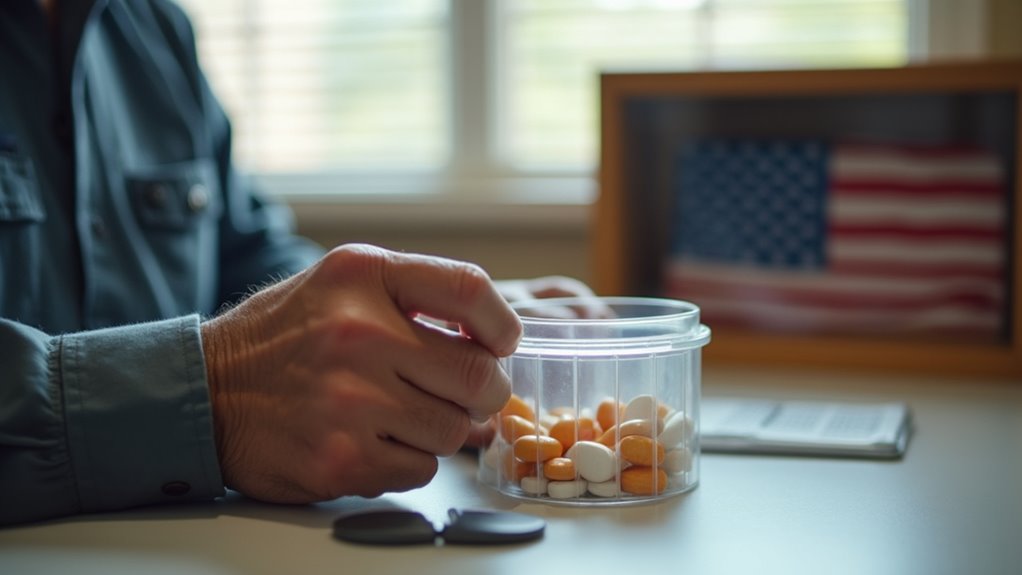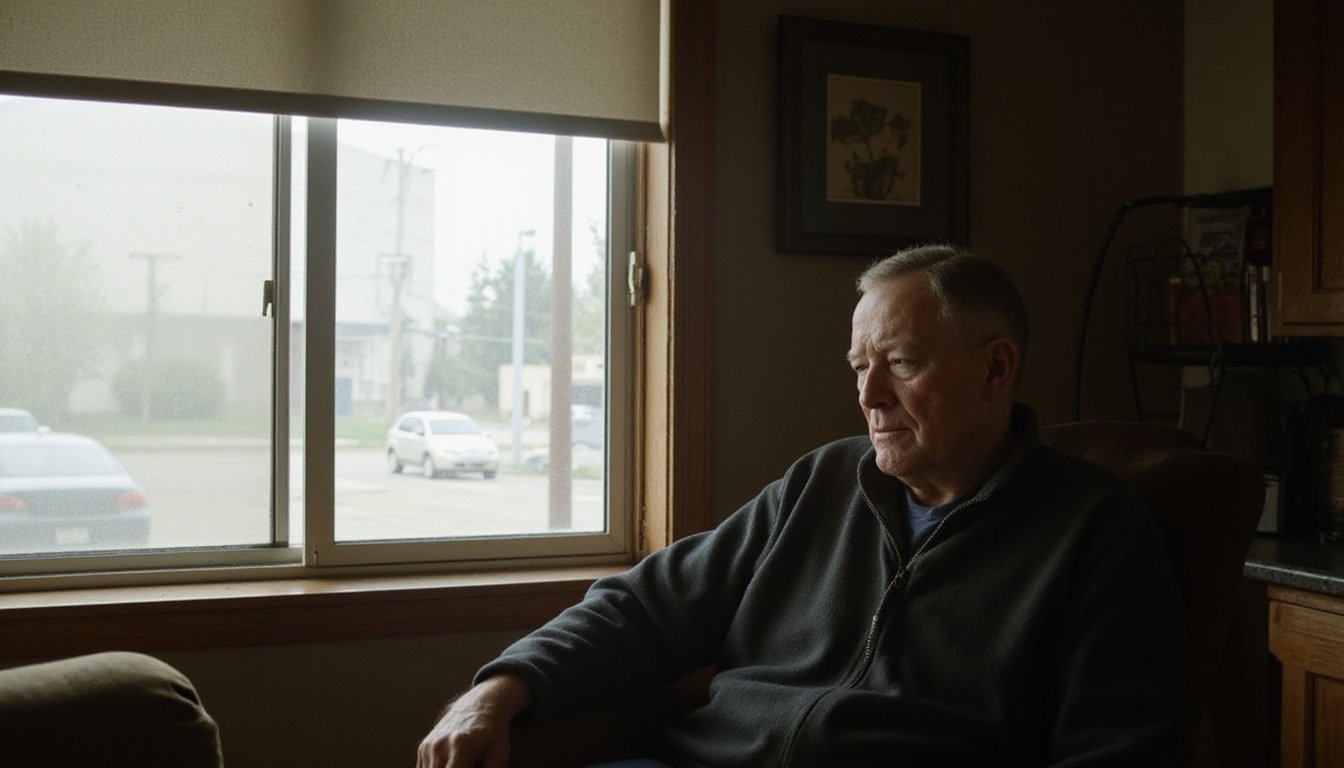Medication-assisted treatment (MAT) greatly improves veterans’ recovery by reducing mortality risks through continuous medication support. You’ll benefit from MAT’s ability to stabilize neurobiology, decrease cravings, and prevent overdoses during high-risk change periods. It’s particularly effective when combined with trauma-focused therapies for co-occurring PTSD, doubling symptom improvement rates compared to standard treatment. Extended-release injectable formulations offer higher adherence rates (54.6%) than oral medications. Uncover how personalized MAT approaches can address your unique clinical profile and overcome treatment barriers.
Reducing Mortality Risks Through Continuous Treatment

While many treatment approaches exist for Veterans with opioid use disorder, medication-assisted treatment (MAT) stands out as a critical intervention for reducing mortality risk. Research shows that continuous treatment produces significant mortality reduction, with methadone treatment ≥4 months or buprenorphine ≥2 months leading to 54 and 65 fewer deaths per 10,000 Veterans annually, respectively.
Treatment duration directly correlates with survival benefits. Even short periods (1-2 months for buprenorphine, 2-4 months for methadone) provide measurable protection, but the greatest benefits emerge after six months of uninterrupted treatment. A recent study by Dr. Watts demonstrated 50% decreased risk of suicide mortality among Veterans receiving MAT. The VA has recognized this importance and established MAT as part of the uniform benefits available to all enrolled Veterans. Early discontinuation, especially within the initial month, substantially increases mortality risk. Proper support during treatment transitions is essential, as these periods show elevated mortality compared to stable treatment phases. The data is clear: longer retention in MAT consistently results in greater mortality reduction, with buprenorphine showing higher probability of benefit than methadone at equivalent durations.
Preventing Overdose During Critical Transition Periods
Veterans face considerably heightened overdose risk during critical change periods such as release from incarceration or discharge from inpatient treatment. These shift challenges coincide with reduced opioid tolerance and potential return to substance use, particularly during the initial weeks post-discharge when mortality rates spike dramatically.
MAT serves as a vital overdose prevention strategy by stabilizing neurobiology and reducing cravings when veterans are most vulnerable. The VHA’s SCOUTT initiative improves MAT access during these high-risk shifts. Evidence shows that continuous medication support markedly lowers overdose rates by maintaining neurochemical balance while providing supervised care. The combination of FDA-approved medications with counseling addresses both physiological and psychological aspects of addiction recovery.
For ideal protection, you’ll benefit from coordinated care that includes naloxone distribution, immediate MAT initiation without administrative delays, and telemedicine options that bridge potential treatment gaps during these dangerous shift periods. Veterans with PTSD require special consideration as they are at higher overdose risk due to complex medication patterns and co-occurring mental health conditions.
Managing PTSD and Other Co-occurring Conditions

Veterans with co-occurring PTSD and substance use disorders benefit markedly from integrated dual diagnosis treatment approaches. Research demonstrates that combining MAT with trauma-focused therapies yields higher retention rates (90.5% at 6 months) and greater improvements in PTSD symptoms (23.7% improvement with buprenorphine) compared to single-focus interventions. You’ll find these integrated care models effectively address the neurobiological overlap between trauma and addiction while reducing mortality risks and supporting sustained recovery through consistent medication adherence and psychosocial engagement. The Department of Veterans Affairs is now exploring MDMA-assisted therapy as a potential treatment option for veterans suffering from PTSD and alcohol use disorder. The unique challenges veterans face when transitioning to civilian life can be better managed through holistic support systems that simultaneously address substance use and mental health difficulties. High exposure to general substance abuse care has been shown to significantly reduce mortality rates in veterans with PTSD and OUD, particularly for external causes and overdose/suicide events.
Dual Diagnosis Treatment Advances
As treatments for veterans with dual diagnoses have evolved, significant advancements in medication-assisted options have emerged for those simultaneously battling PTSD and substance use disorders. The integration of psychotherapy with pharmacological interventions has improved treatment accessibility for veterans with complex comorbidities. The prevalence of comorbid OUD diagnoses in PTSD patients increased from 2.5% in 2004 to 3.4% in 2013.
| Medication | Trend (2004-2013) | Key Demographics |
|---|---|---|
| Buprenorphine | Increased 11-fold (2.0% to 22.7%) | Younger, rural, white, married |
| Methadone | Declined (19.3% to 12.7%) | Older, urban, minorities, unmarried |
| Naltrexone | Rose from 2.8% to 8.6% | 87% with alcohol use disorder comorbidity |
| MDMA | VA-funded research began 2024 | Under investigation for PTSD/SUD |
| D-cycloserine | Mixed results in clinical trials | Variable outcomes with psychotherapy |
Recent epidemiological data indicates veterans with PTSD are up to 14 times more likely to develop substance use disorders, highlighting the critical importance of dual-diagnosis approaches.
Integrated Care Benefits
The integration of medication-assisted treatment (MAT) with trauma-focused therapies represents a notable advancement in treating veterans with co-occurring disorders. When you receive integrated care that addresses both opioid use disorder and PTSD simultaneously, your chances of recovery improve considerably.
Research demonstrates three critical benefits of this integrated approach:
- Retention improvement – You’re 43.36 times more likely to remain in treatment when trauma therapy accompanies your MAT program
- Enhanced symptom reduction – You’ll experience nearly twice the rate of PTSD symptom improvement compared to opioid therapy alone
- Lower mortality risk – Your risk of death from overdose or suicide decreases markedly with consistent MAT and trauma therapy
The four primary antidepressant medications approved for PTSD treatment, sertraline, paroxetine, fluoxetine, and venlafaxine, can be effectively incorporated into comprehensive MAT protocols for veterans with dual diagnoses.
Recent findings suggest that innovative treatments like ibogaine with magnesium may offer promising alternatives for veterans suffering from traumatic brain injuries and associated psychiatric conditions. This coordinated care model guarantees mental health and addiction specialists communicate effectively, providing you with thorough treatment that addresses your complete clinical picture.
Enhancing Long-term Treatment Engagement and Adherence
While preliminary enrollment in medication-assisted treatment (MAT) represents a notable primary step, long-term engagement and adherence remain critical challenges for achieving ideal outcomes among veteran populations. Evidence-based practices show that extended-release injectable formulations yield higher adherence rates (54.6%) compared to oral medications (41.3-49.8%), with more veterans achieving optimal 80% adherence thresholds using injectable options.
Your ongoing engagement correlates directly with improved clinical outcomes and reduced relapse risk. Motivational interviewing techniques, when combined with consistent follow-up and case management, considerably increase your likelihood of maintaining treatment. Veterans experiencing early clinical improvements demonstrate stronger long-term adherence patterns. Multiple factors, including medication efficacy uncertainty, side effects, illness severity, and regimen complexity contribute to suboptimal adherence rates among veterans with alcohol use disorders. Addressing logistical barriers like travel distance and medication complexity is essential, particularly for rural and minority veterans who report lower adherence rates in general. Research demonstrates that low-cost telephone interventions can significantly improve treatment adherence rates for veterans who may otherwise struggle with regular in-person appointments.
Personalizing MAT Approaches for Individual Veteran Needs

Personalizing medication-assisted treatment approaches stands at the core of effective veteran care. Through individualized assessments that consider your unique clinical profile, including comorbidities, combat exposure, and chronic pain, providers can develop customized therapies that address your specific recovery needs.
The personalization process typically includes:
- Medication selection based on substance used, genetic factors affecting metabolism, and existing mental health conditions
- Integration of behavioral therapies that complement pharmaceutical interventions while addressing trauma-specific challenges
- Delivery method optimization utilizing telehealth or in-person services depending on your geographical location and accessibility needs
This personalized approach is particularly significant given the high prevalence of comorbid conditions among veterans, 73.2% with depression and 39.8% with PTSD, requiring careful consideration of medication interactions and thorough treatment planning.
Overcoming Barriers to Effective MAT Implementation
Geographic access disparities present significant challenges for rural and remote veterans seeking MAT services, with transportation barriers often forcing patients to travel long distances for regular treatment. To address these challenges, you’ll find expanding community-based MAT programs through partnerships with local healthcare providers creates critical access points closer to veterans’ homes. VA telehealth initiatives for MAT services further reduce geographic barriers by enabling veterans to receive medication management and counseling support remotely when in-person visits aren’t feasible.
Geographic Access Disparities
Despite significant advances in medication-assisted treatment (MAT) for veterans with opioid use disorder (OUD), profound disparities in access persist along geographical lines. Veterans in rural areas are 37% less likely to receive OUD medications than their urban counterparts, creating significant rural disparities for the 4.4 million veterans living in these communities.
These access challenges stem from multiple systemic factors:
- Provider shortages – Rural facilities face greater difficulties recruiting and retaining qualified staff capable of delivering MAT services
- Transportation barriers – Long distances to treatment facilities without reliable public transportation options impede regular attendance
- Digital divide limitations – Inadequate broadband infrastructure undermines telehealth alternatives that could potentially bridge geographic gaps
Southern regions demonstrate particularly concerning trends, with veterans experiencing lower odds of receiving OUD medications compared to those in the Northeast.
Community-Based MAT Expansion
While the Veterans Health Administration (VHA) offers medication-assisted treatment for opioid use disorder, considerable barriers impede its effective implementation and widespread adoption in community settings. Regulatory restrictions on methadone and buprenorphine create substantial hurdles, with Community Care contributing only 1.8% of all MOUD prescriptions.
Provider shortages and insufficient specialized training limit community outreach effectiveness, though the VA SCOUTT Initiative demonstrates that intensive training can enhance prescribing rates by 169%. Service collaboration remains fragmented across VA, community, and federal systems, particularly affecting vulnerable populations like homeless, Black, and justice-involved veterans who have higher OUD prevalence (up to 10%) but lower treatment access.
Regional disparities further compound these challenges, with Southern VHA facilities reporting considerably lower odds of providing MAT compared to Northeastern counterparts.
Frequently Asked Questions
How Do Family Members Support Veterans Receiving MAT?
Family involvement notably improves MAT outcomes for veterans. You can provide emotional support through consistent encouragement and understanding addiction as a medical condition. Learn about MAT medications and possible side effects to respond appropriately to challenges. Assist with transportation to appointments and daily logistics. Monitor for symptom changes, advocate for thorough care, and connect veterans to extra resources. Maintain open communication with healthcare providers to guarantee coordinated treatment planning.
Can Veterans Continue MAT While Deployed or on Active Duty?
Yes, you can continue MAT while deployed or on active duty, though significant deployment challenges exist. VA policies mandate timely access to evidence-based treatment regardless of location, but availability varies based on deployment setting. You’ll face potential barriers, including medication storage regulations, limited access to required monitoring, and coordination between VA and military medical staff. Continuity of care requires advance planning and documentation to comply with both VA and deployment-site requirements.
What Employment Accommodations Exist for Veterans Undergoing MAT?
As a veteran undergoing MAT, you’re protected by employment rights under the ADA and USERRA. You can request reasonable accommodations, including flexible work schedules for treatment appointments, modified job duties, adjusted break times for medication administration, and private spaces for medication needs. Workplace flexibility options may include remote work when feasible. Your employer must evaluate each accommodation individually, considering essential job functions and potential hardship. The Job Accommodation Network provides technical guidance on implementing these accommodations.
How Does MAT Interact With Pain Management for Injured Veterans?
MAT provides effective pain management for your injuries while mitigating opioid dependency risks. Research demonstrates it doesn’t increase pain severity when reducing opioid use. You’ll benefit from MAT’s integration with extensive pain relief strategies, including non-opioid medications, which show lower pain intensity and fewer side effects. When combined with therapies like ACT and CBT, MAT produces statistically significant reductions in pain interference. VA data confirms that interdisciplinary approaches incorporating MAT improve functionality and general well-being for veterans with chronic pain.
Are There Peer Support Programs Specifically for Veterans on MAT?
Yes, multiple veteran peer support programs exist specifically for those on MAT. The VA Peer Support Program employs veterans in recovery who provide guidance through your MAT process. You’ll find both VA-based and community resources like SAFE Project’s virtual groups where veterans share MAT success stories. Research indicates these peer connections greatly improve your treatment retention and reduce relapse risk. However, availability varies geographically, with rural veterans often experiencing more limited access to MAT-specific peer programs.






